My Eight-Armed Obsession
My introduction to Sancerre parallels my viewing of Whit Stillman films. I had my first Sancerre right about the time I discovered Metropolitan. The film follows tuxedoed and ball gowned members of the Sally Fowler Rat Pack (SFRP), a group of recent college grads whose conversations simultaneously channeled W. Somerset Maugham and Kevin Smith. I imagined that the SFRP, however acutely awkward, already knew how to order wine by appellation, something I learned with Sancerre.
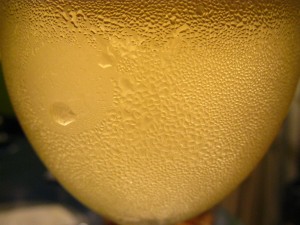 From Sancerre, I quickly jumped to Pouilly-Fumé. At the video store, I picked up Barcelona and The Last Days of Disco. As I teased out each Sauvignon Blanc’s characteristics in reference to their soils and sun exposures, I mentally recorded this gem from Barcelona: “You see, that’s one of the great things about getting involved with someone from another country … when we act in ways which might objectively seem … incredibly annoying, they don’t get upset at all. They don’t take it personally. They just assume it’s some national characteristic.”
From Sancerre, I quickly jumped to Pouilly-Fumé. At the video store, I picked up Barcelona and The Last Days of Disco. As I teased out each Sauvignon Blanc’s characteristics in reference to their soils and sun exposures, I mentally recorded this gem from Barcelona: “You see, that’s one of the great things about getting involved with someone from another country … when we act in ways which might objectively seem … incredibly annoying, they don’t get upset at all. They don’t take it personally. They just assume it’s some national characteristic.”
So it is with the whites of the Loire – to know each appellation is to accept certain inevitabilities. Seeing Sancerre blanc on French bistro menus anywhere made me enjoy it a little less each time; I imagined its tremendous popularity had to have some effect on overall quality. I had not drunk a memorable Sancerre in years until recently when I tried the 2010 Domaine M. Girard Sancerre Blanc Cuvée Silex. With one sip of the Silex, my senses were awakened. Its vivid acidity and notes of clover, green apple and honeydew on the cusp of ripeness kept me coming back to the glass, thirsty for more of the kind of wine that aided me so much in my early learning of French wine. Little wonder that now is the time that Stillman has returned with Damsels in Distress, his first film in 12 years.
To honor the return of Sancerre and Stillman films in my life, I decided to make octopus, an ingredient that I’ve been experimenting with for a few years.
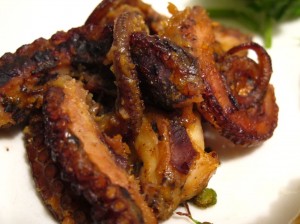
Roasted Octopus with Spicy Miso Glaze
It’s easy enough to make it – just boil it low and slow in a pot of water with a generous pinch of salt and some sort of alcohol until its desired tenderness is reached, then cut it, drizzle it with good olive oil and sprinkle it with paprika, sea salt and freshly chopped herbs. But I’ve yet to achieve the transcendental heights I tasted in an octopus dish I ordered at Lawrence’s Hotel in Sintra, Portugal. (I emailed the hotel for their recipe, but have not received a response.) Having cooked octopi at least 10 times, I know now that the octopi in the Mediterranean must be significantly larger than the ones we get here as they shrink two- to threefold in the cooking process. If you get a big fat piece of tako at a sushi place, I’d say the original cephalopod was over 10 pounds prior to cooking. Thus far, I’ve only found octopi ranging from 2-4 pounds, which are still plenty delicious even without the satisfaction of sinking your teeth into a thick tender tentacle.
The wine’s star shone so bright that I felt it would go best with the pure savory notes of soy sauce and miso – I was interested in how the palate-coating umami notes of the soy-based condiments would interact with the wine’s palate-cleansing vibrancy.

Pan-fried Onigiri
I decided to make Spicy Miso Glazed Octopus and Pan-fried Onigiri brushed with Tamari. My fiancé chipped in with a Watercress Salad with Asian Pear and Pickled Ginger.
We bought a two-pound frozen octopus from New Star Fish Market in Essex Street Market. I have yet to find fresh octopus but read in The Young Man and the Sea by Esca’s David Pasternak that freezing it beforehand helps to tenderize. Alternatively, you can use the pre-freezer method of beating a fresh octopus against the rocks of the Aegean coast.
We wandered by Saxelby Cheesemongers and ran into a smiley Ann who happily gave us a very ripe piece of Cremont, a Vermont Butter and Cheese company cheese that was too gooey to sell, but right in its sweet spot for enjoying with Sancerre. We were thankful to have some amazing cheese to slather on toast points as the octopus cooked.
My hunch that the miso would stop the wine in its tracks was correct. The Sancerre lingered on my palate, seemingly 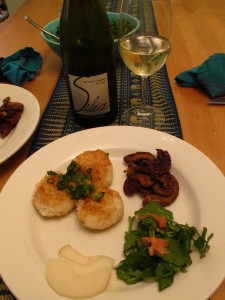 separating and enhancing each ingredient in the glaze. With parallel flavors such as the Asian pear in the salad, the wine also did well to counteract the sharpness of the ginger and bitter watercress.
separating and enhancing each ingredient in the glaze. With parallel flavors such as the Asian pear in the salad, the wine also did well to counteract the sharpness of the ginger and bitter watercress.
I have a feeling that I’ll be uncorking this wine a lot over the summer. Perhaps I’ll take a bottle on a jaunt to the campus on Staten Island where Damsels in Distress was filmed, and hopefully find a BYOB Sri Lankan restaurant while I’m there.
Spicy Miso Glazed Octopus
Ingredients
1 Tbsp. salt
3 Tbsp. cooking sake
1 Tbsp. soy sauce
Water to cover up to one inch below top of octopus
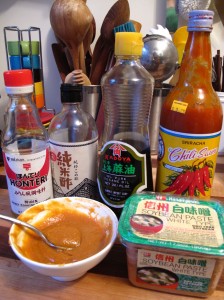
Concocting the spicy miso glaze
1 Tbsp. mirin
1 clove garlic, sliced
2 lb. octopus
Spicy Miso Glaze
3 Tbsp. white miso
1 tsp. sesame oil
1 Tbsp. Sriracha
1 tsp. mirin
1.5 Tbsp. honey
1 tsp. rice vinegar
Give the octopus a quick rinse in cold water, which you’ll likely need to do anyway to release a fully frozen one from its plastic bag. Once liberated, put it in a pot of cold water with the sake, salt, soy sauce, rice wine vinegar, mirin and garlic in it. The water should come up to just an inch below the top of your cube of frozen octopus.
Bring the water to a boil before reducing the heat to a low simmer. Skim the foam off the top about 10-15 minutes into the cooking process or when you notice that a layer has formed.
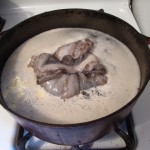
Skim the foam off when it arises, about 20 minutes into the boil
After skimming off the foam, let the octopus cook until it is completely unfrozen and properly resembling a creature of the deep. This will take an additional 20-30 minutes. At this point, take the octopus out and cut it in half. I’ve found that the head and “shoulders” of the octopus takes longer to cook than the tentacles; by cutting it in half, more surface area is exposed to the simmering water and both halves should easily submerge in the pot.
Continue to cook at a low simmer for another 20-30 minutes. During this time, you can mix together the spicy miso glaze. I used the Shark brand of Sriracha, versus the ubiquitous rooster, finding it more to my taste. It’s vinegary with a touch of sweetness in addition to spiciness. Adjust the measurements above to your taste.
At the end of the second 20-30 minutes of boiling, test for tenderness by poking the head and shoulder with the point of sharp knife. The knife should go in but the flesh will still have a good amount of give; think of it as the same amount of resistance you’d feel in your finger if you poked it into a temperpedic pillow.

The octopus halfway through cooking
Let the octopus cool for a few minutes on a cutting board after removing it from the pot. Cut it into pieces and put it in a roasting dish with the miso glaze. The above amount yielded a few tablespoons more than I thought it needed.
Put the pan on a rack one slot down from the top position and broil the octopus on high for 3-5 minutes, stirring halfway through to ensure even caramelization.
Serves 3 normal people, or 2 octophiles.
